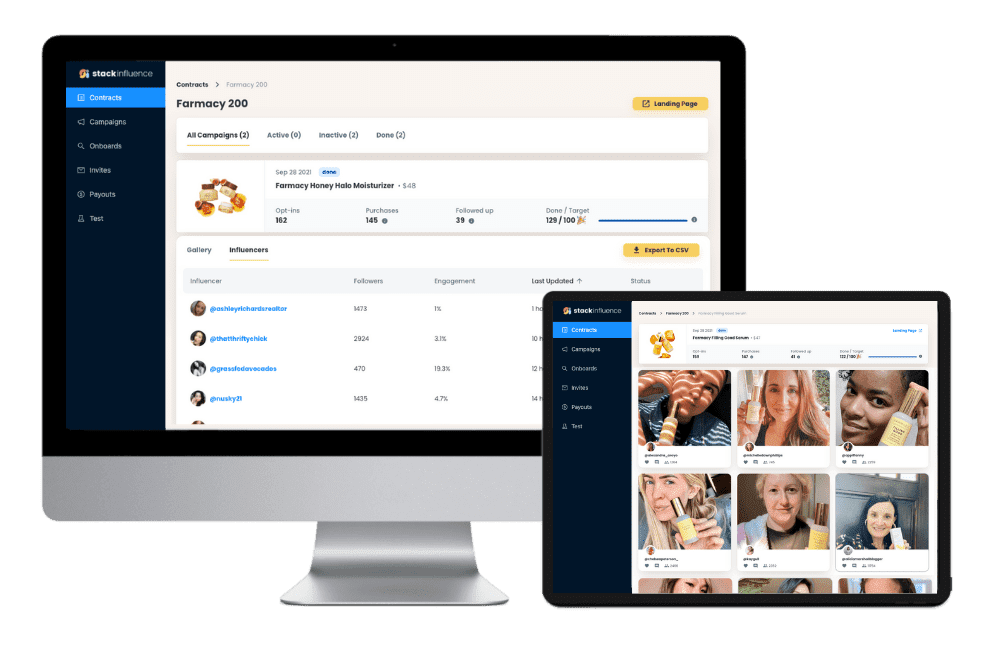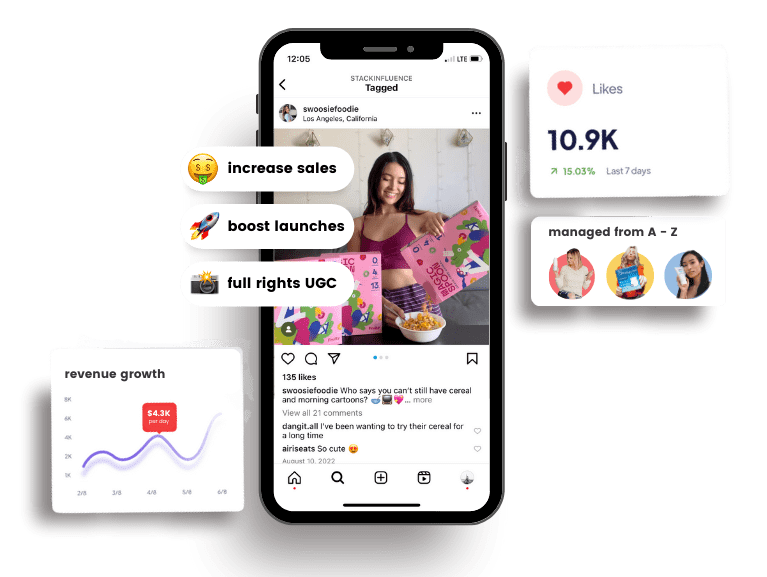What is TikTok Influencer Marketing?
6th
October, 2025
Influencer Marketing
Amazon Marketplace
Artificial Intelligence
TikTok Tips
TikTok has quickly grown from a dance-video app into a powerful marketing platform for e-commerce. TikTok influencer marketing refers to brands partnering with TikTok content creators (influencers) to promote products in authentic, engaging short videos. It’s become especially valuable for online retailers and Amazon sellers, because TikTok drives discovery and impulse buying at an astonishing rate. With around 2 billion users worldwide, TikTok isn’t just for Gen Z dances – it’s a serious e-commerce engine. In fact, roughly 37% of U.S. TikTok users (about 55 million people) made a purchase through the app in 2023. That means TikTok influencer marketing is fast becoming a must-have strategy to boost product awareness and sales for e-commerce brands of all sizes.

Unlock the Power of Micro Influencers and Elevate your Brand Today!

Why TikTok Influencer Marketing Matters for E-Commerce
For online sellers (including Amazon sellers), TikTok offers a perfect storm of huge reach, high engagement, and social commerce features. Here’s why TikTok influencer marketing is so impactful for e-commerce:
-
Massive, engaged audience
TikTok’s user base is enormous and highly active. Users open the app ~8 times a day on average and spend over an hour scrolling. TikTok’s algorithm can push content to millions of viewers overnight, giving brands viral exposure potential that’s hard to match elsewhere.
-
Product discovery & impulse buying
TikTok isn’t just entertainment – it’s a product discovery engine. About 78% of TikTok shoppers say they discover new products through influencer videos. The hashtag #TikTokMadeMeBuyIt (showcasing products people bought because of TikTok) has literally billions of views, driving countless Amazon and online store sales. TikTok even rivals Google for product search among young shoppers – nearly 16% of consumers now start searching for products on TikTok (vs 51% on Amazon).
-
Authenticity and trust through UGC
TikTok content feels more real and unpolished than traditional ads. Influencer posts come off as user-generated content (UGC) – personal reviews, demos, stories – which builds trust. 83% of TikTok users say UGC-style videos make brands seem more authentic. People are more likely to believe “someone like me” on TikTok than a flashy ad.
-
High engagement
TikTok boasts the highest social media engagement rates. The platform’s mix of short video, trends, and algorithmic targeting leads to viewers actually watching and interacting with content. For example, TikTok’s average engagement rate (2.5%) is five times higher than Instagram’s. When an influencer’s content resonates, it can get shares, comments, duets, and remixes – amplifying your brand message through viral loops.
In short, TikTok influencer marketing allows e-commerce brands to reach huge audiences through relatable content that inspires purchases. Next, let’s break down how to leverage TikTok influencers effectively, from choosing the right creators to crafting a campaign strategy.
Micro-Influencers vs. Macro-Influencers: The Power of “Small” Creators

You might think you need a celebrity TikToker with millions of followers to make an impact – but in 2025, micro-influencers (or even nano-influencers) are often the secret weapon for e-commerce brands. Micro-influencers are creators with relatively smaller followings (typically a few thousand to ~50,000 followers) who are deeply trusted by their niche audience. Here’s why “small can be mighty” on TikTok:
- Higher engagement and trust: Smaller creators often have a tight-knit bond with their followers. Their content feels more like a friend’s recommendations than an ad. Data backs this up: TikTok nano-influencers (1k–10k followers) see significantly higher engagement rates than big macro-influencers. For example, nano creators in the fashion niche average ~15% engagement vs only ~3% for macro creators. The chart below illustrates how influencers with small followings outperform larger ones in engagement across categories:
- Affordable collaborations: Top TikTok stars can charge thousands of dollars for a single post – out of reach for many small businesses. Micro-influencers, on the other hand, are far more affordable (sometimes even just free product is enough). On average, a TikTok micro-influencer post costs around $75, whereas a macro-influencer (100k+ followers) might cost ~$1,875, and a celebrity TikTok creator can command $25k or more per post. The chart below (based on industry averages) shows how influencer costs jump exponentially for larger followings:
Average cost for a sponsored TikTok post by influencer tier Working with a handful of micro influencers can often be cheaper than one post from a single mega-influencer.
- Authenticity = conversions: Micro-influencer recommendations often feel genuine. Because these creators focus on specific niches (eco-friendly living, fitness, tech gadgets, etc.), their followers trust their opinions. A shoutout from a micro-influencer can drive higher conversion rates per view than a generic celebrity endorsement. For example, a micro fashion influencer doing a try-on haul of your boutique’s clothing might get fewer views than Charli D’Amelio, but the viewers are exactly your target customers and more likely to buy after seeing someone they trust wear your product.
- Scale and agility: Instead of betting your budget on one big influencer post, you can spread products across 20+ micro-influencers. This diversifies your reach and reduces risk – if one post flops, others can still perform. Collectively, a team of micro influencers can generate a tidal wave of UGC content about your brand. It also allows you to test different content styles and niches quickly. Many micro-influencers are eager to work with brands, making it easier to launch campaigns fast.
Tips for working with micro-influencers:
- Find the right fit: Look for micro influencers whose niche and style align with your brand values. Relevance matters more than follower count. For instance, a micro-influencer who posts DIY home decor videos would be ideal if you sell handmade crafts.
- Engage authentically: Give influencers creative freedom to introduce your product in their own voice. Rigid scripts can feel fake – it’s better to suggest themes or talking points and let them run with it. The content will come off more authentic if the creator’s personality shines through.
- Provide perks: Even if you’re not paying large fees, treat your micro influencers well. Send them free products (so they can genuinely try them out), offer exclusive discount codes for their followers, or even a small commission per sale. These incentives keep creators motivated and excited to promote your product.
- Build relationships: When you find a micro-influencer who really moves the needle (drives sales or traffic), consider a longer-term partnership. Making someone an ambassador for your brand over multiple posts or months can yield better results than a one-off mention. Their followers will consistently see them loving your brand, which boosts credibility and awareness.
Bottom line: Don’t underestimate the power of micro and nano influencers on TikTok. They bring authentic word-of-mouth marketing at a fraction of the cost, which is perfect for e-commerce startups and Amazon sellers on a budget. By leveraging many small creators, you can flood TikTok with genuine chatter about your product and create a snowball effect of awareness.
Leveraging User-Generated Content (UGC) for TikTok Marketing
One reason TikTok influencer campaigns work so well is that they produce user-generated content (UGC) – relatable videos that feel like real customer experiences. UGC is essentially any content about your brand that isn’t created by your brand’s official team (e.g. a customer’s unboxing video, a fan’s tutorial using your product, or an influencer’s “day in the life” featuring your item). In 2025, TikTok UGC has become marketing gold because it delivers what consumers crave: authenticity and trust.
Why is UGC so powerful on TikTok? It feels real, unpolished, and honest. TikTok users often scroll past obvious, polished ads, but they stop for raw, genuine moments. A video shot on an iPhone by a happy customer can often outperform a slick professional ad. In fact, 83% of TikTok users say UGC-style videos make brands seem more authentic, and brands using UGC content see much higher engagement – about 35% higher watch-through rates compared to glossy ads. People are more likely to watch (and trust) content that looks like it came from “people like me.” It’s no surprise that roughly 60% of TikTok’s brand engagement now comes from UGC content.
For e-commerce sellers, running UGC campaigns on TikTok is a no-brainer to build credibility and even spark virality. Influencer marketing on TikTok essentially creates UGC for your brand. Here are some ways to leverage UGC in your TikTok strategy:
-
Encourage real customers to share
Actively invite your buyers to post their experiences. For example, include a small insert in product packages saying “Share a TikTok of you using our product and tag us @YourBrand for a chance to be featured!” You can even suggest a hashtag. Many people love showing off cool finds or joining trends, so give them a nudge.
-
Run UGC contests or challenges
Create a fun TikTok challenge related to your product and offer an incentive. For instance, a kitchen gadget brand could launch a #HolidayHacks challenge asking users to film a holiday cooking hack using the gadget, with a chance to win a gift card. TikTok’s own branded hashtag challenges have shown that a catchy challenge can generate a flood of UGC and new followers. Contests give users a reason to create content about your product, essentially crowdsourcing your marketing.
-
Influencer-UGC hybrids
Partner with micro-influencers to produce content that looks and feels like organic UGC. In practice, this means giving a few creators your product and having them create TikToks as if they were regular happy customers. (This is exactly what Stack Influence campaigns specialize in – the influencers post content that feels authentic and UGC-like). With permission, you can then repost those videos on your own channels or even run them as TikTok Spark Ads to reach a wider audience. The beauty is that even though it’s a paid collaboration, the content retains that lo-fi, genuine TikTok vibe.
-
Feature UGC on your brand profile (and beyond)
Make your customers and influencers the stars of your TikTok page. Regularly share the best UGC or influencer-created videos on your official account (always credit the creator!). This not only provides social proof to your followers but also encourages more fans to create content in hopes of being featured. You can repurpose TikTok UGC elsewhere too – e.g. share clips on your Instagram Stories, in your email newsletters, or even embed them on product pages as testimonials. Each piece of UGC becomes a mini advertisement that you didn’t have to produce yourself.
A huge example of UGC-driven commerce is the #TikTokMadeMeBuyIt phenomenon. This community hashtag – with billions of views – is full of everyday people showing off products they purchased because they saw them on TikTok. Smart e-commerce brands are hopping on this trend by tagging their own product videos with #TikTokMadeMeBuyIt to get discovered. If an item gains enough traction under this tag, it can snowball into a viral hit where everyone suddenly “needs” it because TikTok made them do it. Many Amazon sellers have seen their products sell out thanks to this kind of viral TikTok exposure. Similarly, the hashtag #AmazonFinds (showcasing cool products available on Amazon) has over 64 billion views on TikTok – a clear sign that TikTok can send hordes of shoppers to Amazon listings. By aligning your campaigns with these organic trends, you tap into a massive social proof engine.
Key takeaway: UGC content on TikTok builds trust and community around your brand. Modern consumers (especially Gen Z and Millennials) want to engage with real stories and peer recommendations, not faceless corporate ads. By integrating UGC and influencer content into your marketing, you make your brand feel like part of the TikTok community conversation. This authenticity translates into higher engagement, more loyalty, and ultimately more sales.
How to Launch a TikTok Influencer Marketing Campaign (Step by Step)
Ready to leverage TikTok influencers and UGC for your own e-commerce brand? Here’s a step-by-step strategy to get your campaign off the ground:
1. Set clear goals and KPIs
First, decide what you want to achieve. Is your aim to build brand awareness? Drive traffic to your online store or Amazon listing? Boost sales of a specific product? Having clear objectives will guide your campaign. Define key metrics like views, engagement (likes/comments/shares), click-throughs on your link, or use of a promo code. For example, an Amazon seller might track an increase in product page visits or a bump in sales rank during the campaign.
2. Research your target audience on TikTok
Understand who you want to reach and what content they enjoy. TikTok’s user base skews young (teens and 20s), but it’s broadening. If you sell beauty products for instance, look at what beauty content is trending on TikTok and which creators are leading those conversations. Identify relevant hashtags, trends, or communities (e.g. #CleanTok for cleaning hacks, #BookTok for book lovers, etc.) that align with your brand.
3. Find the right influencers
Discover creators who match your niche, have an engaged following, and align with your brand personality. You can use TikTok’s search and hashtag browsing to find creators organically, or leverage influencer marketing platforms/databases. (Tip: Micro-influencers are often a great starting point – as discussed, they’re cost-effective and authentic. Ensure to vet each influencer’s content quality and audience (look at their comments, engagement rate) rather than just follower count.) Compile a shortlist of influencers who you believe can authentically represent your product.
4. Amplify the best content
If an influencer’s video is performing really well or is just exceptionally good, consider amplifying it. You have a few options: (a) Repost it on your own TikTok profile (giving credit to the creator) to share with your followers. (b) Share it on other social channels like Instagram Reels, YouTube Shorts, Facebook, or in your email marketing – multi-purpose that great content! (c) Use TikTok’s “Spark Ads” feature to turn the influencer’s post into a sponsored ad. Spark Ads allow you to promote an organic TikTok post (with the creator’s permission) as an ad, so it reaches a wider audience beyond the creator’s followers. This can be a powerful way to combine authentic content with paid boosting for more views and conversions.
By following these steps, you’ll develop a repeatable process for tapping into TikTok’s influencer ecosystem. Remember, successful TikTok marketing often involves some experimentation – trying different creators and content styles to see what clicks with your audience. Stay agile and keep a pulse on TikTok trends, and you’ll be able to ride the platform’s momentum to boost your brand’s visibility and sales.

Unlock the Power of Micro Influencers and Elevate your Brand Today!

Conclusion to What is TikTok Influencer Marketing?
TikTok influencer marketing is no longer an optional experiment for e-commerce brands – it’s a proven strategy to drive awareness, traffic, and sales. In the past few years we’ve seen countless examples of small businesses selling out products thanks to a single TikTok video, and major brands scaling new heights by collaborating with TikTok creators. The formula of authentic content + engaged audience is incredibly potent. By working with micro-influencers and encouraging UGC, even Amazon sellers and new e-commerce startups can generate big buzz without a big budget.
The key is to approach TikTok as a unique culture: be creative, be genuine, and be ready to adapt quickly to trends. Whether it’s a skincare guru giving an unscripted review of your serum, or a group of nano-influencers each showing your gadget in action, the content will feel like a recommendation from a friend – and that is marketing magic. With 61% of marketers now using TikTok for influencer campaigns, those who ignore the platform risk missing out on the next generation of consumers. So consider this your sign to grab a coffee, open up TikTok, and start brainstorming how your brand can collaborate with the vibrant community of TikTok creators. By implementing the strategies and tips outlined above, you’ll be well on your way to launching effective TikTok influencer campaigns that help your e-commerce brand stack influence (pun intended) and thrive in the new age of social commerce.

By William Gasner
CMO at Stack Influence
William Gasner is the CMO of Stack Influence, he's a 6X founder, a 7-Figure eCommerce seller, and has been featured in leading publications like Forbes, Business Insider, and Wired for his thoughts on the influencer marketing and eCommerce industries.
Want new articles before they get published? Subscribe to our Awesome Newsletter.
stack up your influence
turning creativity into currency
our headquarters
111 NE 1st St, Miami, FL 33132
our contact info
[email protected]
stack up your influence
turning creativity into currency
our headquarters
111 NE 1st St, 8th Floor
Miami, FL 33132


